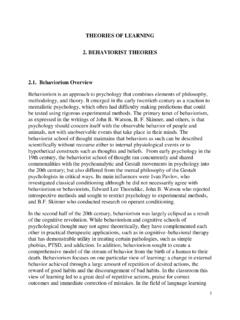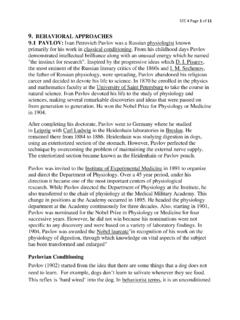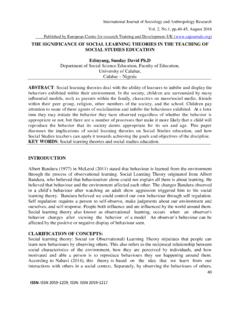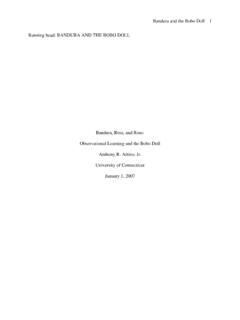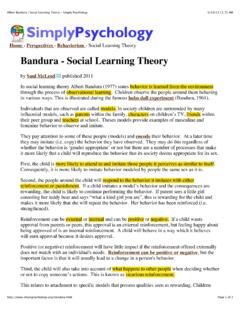Transcription of Unit 2 Additional Guidance
1 Unit 2 Additional Guidance BTEC Level 3 National in Uniformed Protective Services Unit 2: Behaviour and Discipline in the Uniformed Protective Services (40888M) 2 Table of Contents Key Studies Guidance .. 4 Behaviour Theories .. 5 Obedience Theories .. 19 Conformist Theories .. 22 Theories Related to Stress .. 25 Other Sources .. 31 3 BTEC Level 3 National in Uniformed Protective Services Unit 2: Behaviour and Discipline in the Uniformed Protective Services 4 Key Studies Guidance This guide contains summaries of the Unit 2 Key Studies as background information for teachers.
2 Learners will not be expected to have this level of detail of the named studies, please refer to the specification. 5 Behaviour Theories 1) Behaviourist The behaviourist theory is based on the principle that children come into the world as blank slates. All learning is influenced by the environment around them, in the same way that it would be for animals. Using this assumption, behaviourists believe that human and animal behaviour can be explained through the use of conditioning. Thoughts and feelings are not considered to influence behaviour and neither do inherited factors, and psychological disorders can be treated through changing patterns of behaviour.
3 In other words, behaviour is based on our response to the stimulus individuals are subjected to and is not as a result of inherited factors. Key Vocabulary: Classical Conditioning The use of a familiar stimulus to influence behaviour towards a new stimulus by repeatedly pairing them together. Operant Conditioning The use of reinforcement, both positive and negative, to influence how new behaviours are learnt and how old behaviours are modified. Positive Reinforcement A reward or praise.
4 Negative Reinforcement The removal of an unfavourable outcome. Stimulus A thing or event that causes an individual to react. 6 Key Information: Ivan Pavlov - Classical Conditioning (1890 s) Pavlov conducted studies into the digestive systems in dogs. During his studies, he noticed that the dogs would salivate when they were presented with food - and if they saw the white lab coat of the assistants who brought the food. This observation led Pavlov to discover that the dogs had associated the presentation of food with the lab coat, conditioning them to behave in the same way.
5 Using this discovery, Pavlov conditioned the dogs to salivate in response to the sound of a bell by ringing the bell when they were given food. By pairing the bell (the new stimulus) and the food (the familiar stimulus) together, Pavlov had conditioned the dogs to salivate when they heard the bell, even when there was no food. Burrhus Frederick Skinner - Operant Conditioning (1948) Skinner believed that all human behaviour was the direct result of conditioning. He believed that free will did not exist.
6 Skinner developed an operating conditioning apparatus, which is now known as the Skinner Box, and used this to test behaviour in rats. This was used to understand how long it would take the rat to learn a new behaviour. By pushing a lever (accidentally at first) in the box and receiving a reward, the rat would learn to perform that behaviour. When the rats were given a reward after pressing the bar, they were more likely to press the bar again. Rats that were not given rewards were less likely to press the bar.
7 7 Unlike Pavlov, Skinner found that behaviour was influenced by what happened after the behaviour and not before it. Skinner also found that behaviour could be influenced by positive or negative rewards, and punishment played a role in influencing behaviour. Albert bandura - Social Learning Theory (1961) Albert bandura s theory was based on the idea that individuals learn from observing others, imitating and modelling. In his experiment, bandura showed a group of children a film of an adult hitting and shouting at a Bobo doll.
8 When the children were later taken to a playroom containing a Bobo doll, those who had seen the film were more likely to treat the doll badly, imitating the words and language used by the adult in the film. This study was different to those conducted by previous behaviourists. The children were offered no reward to treat the Bobo doll badly. The only stimulus the children had been given was the social influence from the film. The theory believes that individuals learn through two processes: modelling and reinforcement.
9 Individuals are likely to model themselves on people they can relate to, like individuals in the same role or of the same gender, and that as they observe their behaviour, they attempt to copy it. Reinforcement is important because if an individual s behaviour is reinforced or rewarded in some way it is likely that the behaviour will be repeated. In the Uniformed Protective Services, the police, for example, may be considered role models. When undertaking a role as a police officer, individuals are trained to consider their role in shaping the attitudes and opinions of the public and the perception of individuals towards the service.
10 8 2) Psychodynamic The psychodynamic approach is based on the principle that behaviour is explained by unconscious thoughts and emotions. Human behaviour is decided by wishes and feelings that individuals are mostly not aware of, that are developed during childhood. This theory is most closely associated with the work of Sigmund Freud (1890-1930), who introduced the topographic model of the mind, often compared to an iceberg. Key Vocabulary: Conscious Mind The experiences of the senses in the here and now.










